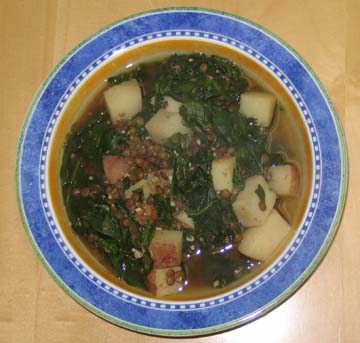Kale used to be on the (short) list of vegetables I don’t like. Brussels sprouts are still there. This is not to be confused with onions, which are on the short list of vegetables that don’t like me. We kept getting kale in our CSA, and didn’t want to always be giving it away (especially because we only had one friend who wanted it). Plus, it’s really, really, really good for you. So we kept trying different things, hoping to find some way that kale was palatable.
After a few tries, I came up with a kale-lentil-lemon soup seasoned with Garam Masala that I like a whole lot, and my husband likes, too. (The recipe is in week 5.) For a couple of years, any time we got kale, I made the soup. Sometimes we ate it fresh, sometimes it went into the freezer. Soup takes up a lot of space in the freezer, so then I learned to blanch and freeze the kale to be made into soup later.
Then a funny thing happened. We got used to the taste of kale, and started eating it prepared in other ways. I learned that I like kale with Indian sorts of seasonings, like curry, turmeric, and cumin. The spiced potatoes and kale I made in week 31 is a good example of that. We’ve reached the point that we’ll use kale in any leafy green recipe, if kale is what we happen to have. Especially if it’s winter and any leafy greens are a treat. (That’s the locavore in me talking.) Our use of kale in the Green Cafe-inspired usually-collards recipe in week 30 was a good example of that. Of course, that recipe still has strong, spicy flavors like cumin and cayenne. So maybe it’s still all about the seasonings.
This week we got kale again. (Notice a theme?) I paired it with lentils and Indian seasoinings. Some of the soup idea, some of the seasonings idea. The lentils had to simmer for about 45 minutes before they were ready to be added to chopped kale in a skillet with oil, garlic, salt, and the whole spice rack: a lot of curry powder and turmeric, about half as much cinnamon, coriander, cumin, and ginger, and a bit of cayenne. The whole mess went over rice. It was easy and tasty, so I’d definitely make it again.
Kale was just one of the things we got from our CSA this week. Due to some sort of a distribution problem, they ran out of large shares before we got to the pick up, so they gave us two small shares instead. That made sharing with the other couple very easy! We got what has become a typical share: apples, carrots, a bag of arugula, and one onion from Massachusetts; potatoes, sweet potatoes, and the aforementioned kale from North Carolina; and oranges and a green bell pepper from Florida.
On the night we got the share, when it was freshest, we made an arugula salad with diced apple and cheddar cheese (Cabot, of course). The apple wasn’t as crunch as I would have liked, but it was crunch enough and the flavors complemented each other beautifully under a homemade balsamic vinaigrette.
Another apple or two were diced into oatmeal (cut oats, not rolled) and allowed to stew down partway to applesauce. There was also cinnamon involved, and some cloves and ginger. We poured maple syrup onto our bowls to sweeten it.
Two of the dozen butternut squash around our kitchen were showing signs of rot, so I figured I’d better make a meal around their salvageable parts. Turns out it’s easy to cut out the rotten part of a squash and still have good parts that really are good. Between the two part-rotten squashes, what I got was equivalent to a bit more than one squash. I cubed it, boiled it until a fork went in easily, then drained the cubes and mixed in butter, lots of sage (dried, because that’s what we have), salt, and pepper. It made enough to top one pound of penne pasta, and worked out to be four servings.
We dipped into the freezer this week, too. One supper was a stir-fry of pan-browned tofu, Asian eggplant from the freezer, and organic soba noodles (because we’re lucky enough to have a local Asian grocer who carries such things). I mixed a sauce from jarred ginger, minced garlic, bottled Hoisin sauce, rice vinegar, and soy sauce. What makes this meal stand out for me was that the eggplant came out with a good texture. I’d been very worried that blanching and freezing it would soften it too much. Apparently I got the blanching time right, because it was still nicely chewy.
The fresh pepper and a half dozen carrots went into a tabbouleh, along with parsley frozen this summer. The texture on the parsley isn’t very good, of course, but it’s still quite edible. I also put chickpeas into my tabbouleh to make it a very complete meal. The discovery that I can put any raw vegetables (finely chopped) into tabbouleh was very liberating. There are too many other things to do with tomatoes. My favorite tabbouleh is with cucumbers. As long as there’s bulghur dressed with olive oil, lemon juice, salt, pepper, and spices (usually parsley, mint, and garlic), it’s tabbouleh and a good lunch.
In Animal, Vegetable, Miracle author Barbara Kingsolver asks “What do you eat in January?” and answers “everything!” This week we ate fresh, stored, and frozen vegetables. I don’t know what to make for dinner tonight because there are too many options. All through harvest season we eat whatever will spoil soonest. Now we don’t have anything threatenting to spoil imminently. What a luxury!
